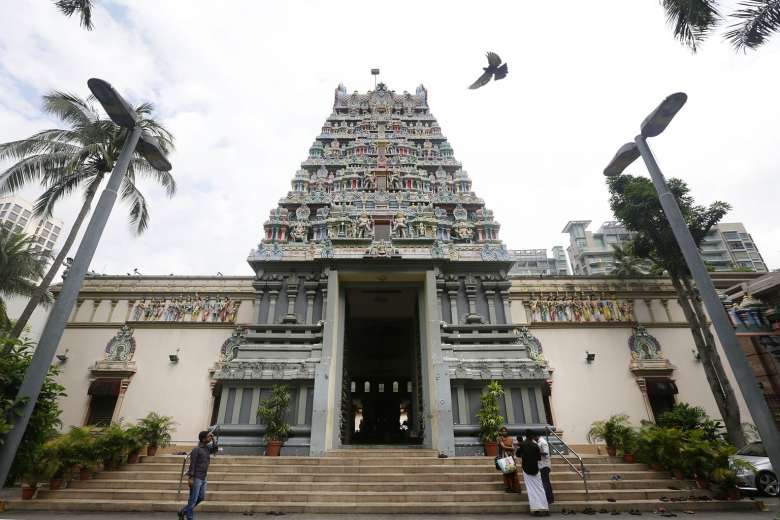The Sri Thendayuthapani Temple in Tank Road began as a shrine under a pipal tree used by the Chettiars in the 19th century. Its current building was gazetted as a national monument in 2014.ST PHOTO: KEVIN LIM
From places of worship and educational institutions to the former residences of prominent figures, 72 buildings here have been gazetted as national monuments. This is the latest in a weekly series revisiting these heritage gems. Each is a yarn woven into the rich tapestry of Singapore’s history.
For the first time in his short three months on earth, little Arian Vel Gerard is having his hair cut. All of it.
In traditional Hindu fashion, a thin layer of bright yellow sandalwood powder will be applied to his shaved baby head, as a salve.
Just like his father before him, baby Arian was taken to the Sri Thendayuthapani Temple early on Sunday morning to have his head shaved as part of the Hindu custom of tonsure.
Done as both an act of humility before God and a rite of passage, providing for the ritual is just one of the many roles that the Tank Road temple has played in modern Singapore over its 158-year history.
Now an important institution in the larger Hindu community and Singapore society as a whole, the temple began as a humble shrine under a pipal tree used by the Chettiars in the 19th century.
The Chettiars are a sub-community of ethnic Tamils hailing from South India who first came to Singapore as private financiers, moneylenders and bankers under the British government in the 1820s.
The temple’s first concrete structure was consecrated on April 4, 1859. Since then, it has been the site of performances and festivals, the intimacies of daily prayer and the extravagances of huge weddings.
In 1981, the old building was demolished, and the current temple was consecrated on Nov 24, 1983. It was gazetted as a national monument on Oct 20, 2014.
The reconstruction added a wedding hall, staff quarters and a Raja Gopuram – the ornate, monumental arch over the temple entrance.
Housing one of the largest Hindu wedding halls in the country, the temple is a popular place for traditional weddings.
Mr Chandra Mohan Kottasamy, 39, and Ms Nanthakumahie Gunasegaran, 32, were married there on Nov 28, 2015, with a guest list of over a thousand.
“To have our wedding there was really special; the temple is so grand but still warm and inviting,” said Mr Mohan, the operations managerof a travel agency.
The temple’s name, Sri Thendayuthapani, refers to a form of the Lord Murugan, the central deity venerated by Chettiars and other South Indians across the region.
Encased in a sphere without his two wives by his side, “Thendayuthapani was especially meaningful in the early days, as the Chettiar men had to cross the seas alone without the company of their wives and children,” said Mr Alagppan Annamalai, 38, the assistant secretary of the temple society.
But the temple is more than just a hub for the Chettiars in Singapore.
Every day, the temple’s priests administer the prayers of over a hundred devotees who come to the temple during its opening hours of 8am to 12pm and 5.30pm to 8pm.
Personal prayer requests can be made by means of a chit containing the name and birth star of the devotee and the deity he or she wishes to address.
“It’s not only part of my routine, it’s something that I enjoy,” said Mrs Vandana Binwani, 61, a school discipline mistress who visits the temple every Sunday.
In addition to daily rituals, the temple conducts many religious and cultural festivals that play an important role in Tamil culture and tradition.
Every year in October, the temple conducts the Navarathiri festival, or the festival of nine nights, in honour of the Goddess Shakti.
The festival is focused on the arts and, in recent years, has served as a platform for young practitioners of traditional music and dance to perform to an audience. The temple is also essential in the celebration of Thaipusam, a festival dedicated to Lord Murugan and one of the largest public events of the year.
The temple serves as the end point for the annual procession of up to 50,000 devotees of all races that occurs during the full moon between January and February.
During the procession, male devotees carry heavy structures adorned with bells and feathers, known as kavadi, and women carry milk pots, all in honour of the Lord Murugan.
The temple and the Hindu Endowments Board jointly support the logistics and religious functions of the 4km procession from Sri Srinivasa Perumal Temple in Serangoon Road, along with all the food and drink that devotees need.
During Thaipusam, the temple’s kitchens open as early as 2am, feeding up to 14,000 people in the course of the day.
“Without this temple, there is no Thaipusam,” said Mr Narayanan Somasundaram Narayanan, 59, a business owner who has carried the kavadi during the procession for over 20 years.
Indeed, for 11/2 centuries, the temple has remained relevant and necessary to the public it serves, and there is no indication that this is about to change.
For little Arian’s family, the temple has been a pillar for three generations.
“It is a custom for us, since I went through it as a child and my father before me. Arian took it very well. We were expecting him to cry and all but he was very calm.” said Mr Sakthi Vellan, 36.






